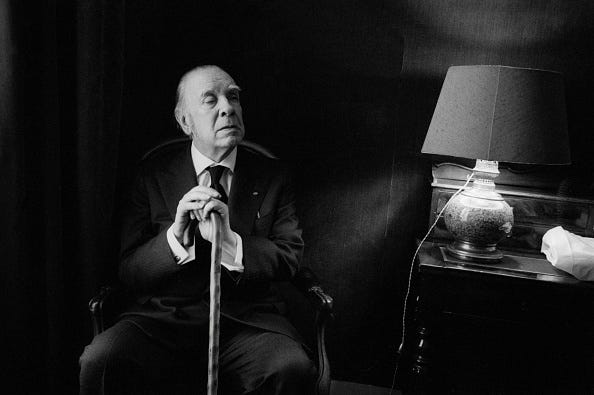Light and Darkness
Borgesian meditations on the here and after

“In death we shall rediscover all the instants of our life and we shall freely combine them as in dreams.”
“To be immortal is commonplace; except for man, all creatures are immortal, for they are ignorant of death; what is divine, terrible, incomprehensible, is to know that one is immortal.”
“Death is the essence of life. Life is an approaching death.”
~ Quotes by Argentina’s immortal man of letters, Jorge Luis Borges (1899-1986)
Joel Bowman, en route to his home in Buenos Aires, Argentina...
Everything is illuminated against its opposite; truth against fallacy; light against darkness; life against death. And who would have it any other way, even if they could? What would life on this mortal coil be, for instance, without the eternity of its terminally mysterious counterpoint?
If there exists a perfect setting for these and associated meditations, it must surely be the magnificent Recoleta Cemetery, located in the beating heart of Buenos Aires. On any given weekend, this sacred resting place for thousands of the city’s most famous – and infamous – people is one of the liveliest places in town. Notable interments include a who’s-who list of Argentine writers, painters, poets, musicians, scientists and luminaries from other noble fields of interest. And, because nothing, including death, is beyond the law of equilibrium, a handful of politicians also rot underfoot.
Tourists pour in to adorn Maria Eva Duarte de Perón’s grave with flowers, for instance, bypassing the resting place of a Nobel Prize-winning chemist and a dozen honest writers to do so. Other, temporary attendees pose with Colgate smiles to have their picture taken beside weeping cement angels, frozen, as they are, in a state of perpetual sorrow. Young boys give the “peace” symbol next to the generals’ tombs whose armies laid to waste to tens of thousands of men, not much older than they, the bodies of whom are long forgotten, their makeshift graves unmarked.
Nowhere does irony live a fuller life than in the Recoleta Cemetery.
Anguish and Triumph
Walking among the deceased, reading bookend dates on the bronze plaques, one is reminded of the finite nature of all things; organisms, political regimes, class structures. When the cemetery was constructed, back in 1822, it must have been a good ride from the exclusive barrios of San Telmo and Montserrat. The rich probably wouldn’t have been caught dead around the grounds of the Monks of the Order of the Recoletos, nor near the shabby, patchwork graveyard that was built there the same year the group disbanded.
Half a century later – and with Argentina still reeling from the War of the Triple Alliance and its own, subsequent civil war – a yellow fever epidemic tore through the capital city. Its wealthier, southern quarters were among the worst hit areas. Death toll estimates range from thirteen to twenty-five thousand. The clase alta packed up and moved north, largely into and around the Recoleta barrio. As such, the marbled vaults came to be populated with members of this same aristocracia, who, though they escaped the fever, came to rest here eventually just the same.
Today, you could buy an entire building in San Telmo for the same price as some of the finely appointed apartments in Recoleta. An entire block in Montserrat might go for half that much.
And so it goes. People die…cities and empires crumble to the ground…and time, indifferent to the fleeting anguishes and triumphs of men, presses on.
Terminus Ahead
On a comfortable Sunday afternoon in late February, an elderly group of well-dressed gentlemen met at their favorite restaurant, right by the gate to the Recoleta Cemetery, for lunch. They took a table outside, one in the shade and with a view of the passing foot traffic. The waiters, having brought the regulars the same thing, more or less, every Sunday for as long as they could remember, immediately set about filling their table. There was juicy bife de lomo and rich chorizo sausages, mozzarella and buffalo tomatoes and papas fritas à la provençal by the pile. Rich, Argentine malbecs and cabernets flowed freely and the merriment of the group soon became infectious. The caballeros flirted with the pretty waitresses and joked with patrons at the nearby tables.
After more than a few bottles, one of the gentlemen got chatting with an Australian writer of no particular importance.
“I am a judge here,” he eventually told the younger man. “My friends and I have seen it all in this city…riots, economic crises, war, people’s entire life savings wiped out overnight.”
One of his friends lent over and placed a knowing hand on the judge’s shoulder. “Today, we enjoy the moment,” he said to his lifelong friend, before adding, one long finger pointed over the cemetery wall, “because tomorrow…ha ha…well, you know our next stop old man.”
And the table erupted in laughter, as the sun set over the angel’s heads in the background.
Hasta la próxima,
Joel Bowman



Thanks for the repost, mate! Can’t wait to get back to the Paris of the South. Been away too long...
Seems to be a theme that is in the air.